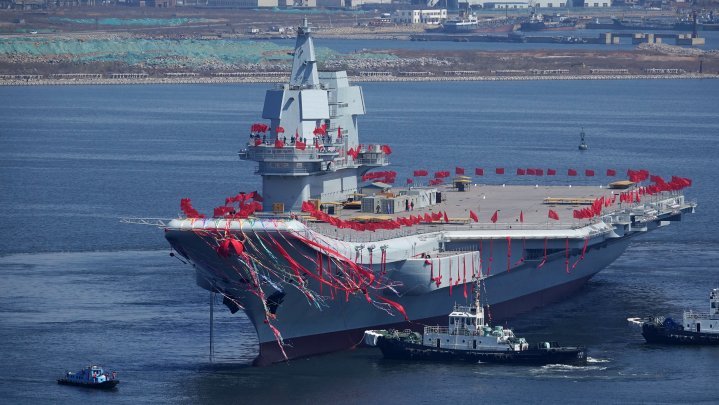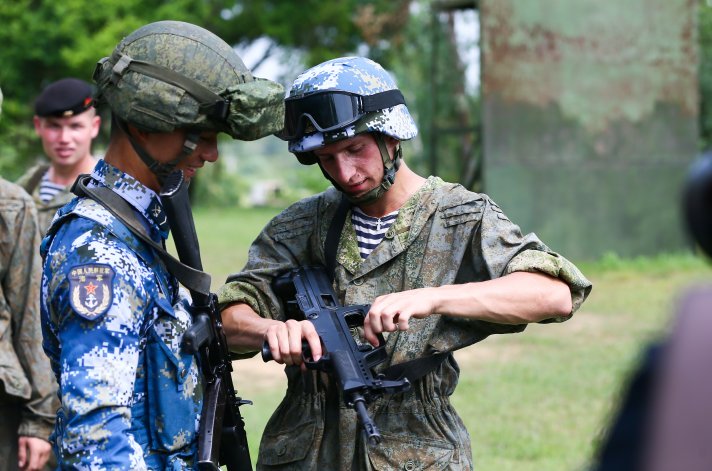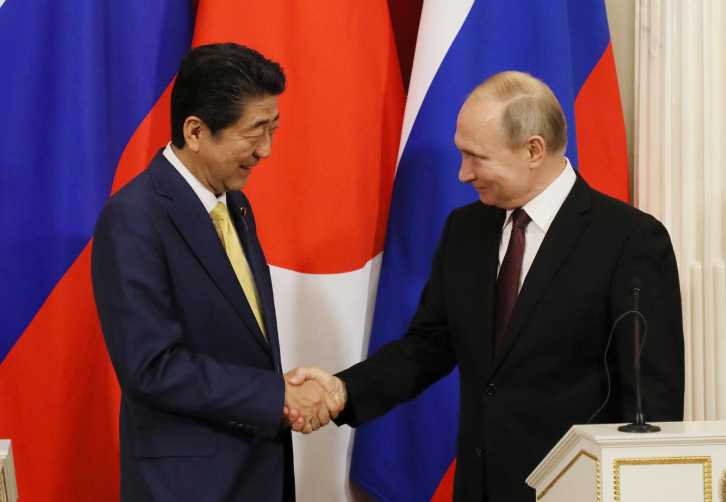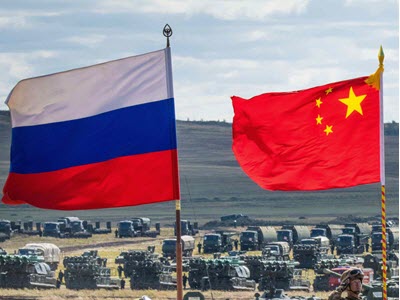China and Russia in the Western Pacific
Implications for Japan and the United States
This essay first overviews Chinese and Russian military activities in the western Pacific. It then analyzes Sino-Russian military cooperation and discusses its implications for Japan and the United States.
China’s growing maritime power is changing the military balance among Asian countries. The continental power of Russia and China dominates the Asian landmass, while the maritime power of the United States and Japan secures freedom of the seas in the western Pacific. Neither side can project sufficient conventional power into the realm of the other. [1]
After the Cuban missile crisis of 1962, the Soviet Union learned the importance of sea power and by the early 1970s had developed the world’s second-largest navy. By the 1980s, the Soviet Union had reinforced its naval and air forces in the Far East, both nuclear and conventional, in an attempt to make the Sea of Okhotsk a “sanctuary,” or a strategic bastion, for its nuclear-powered ballistic missile submarines (SSBNs). In response, the United States and Japan, while opening to China, which maintained large land forces along the Sino-Soviet border, strengthened their combined sea control and contained the Soviet Pacific Fleet within the Sea of Japan. [2]
However, China’s development of anti-access/area-denial (A2/AD) capabilities is now challenging the United States’ and Japan’s maritime supremacy in the western Pacific. Japan’s latest National Defense Program Guidelines show concern about China’s rapid quantitative and qualitative improvement of nuclear, missile, naval, and air capabilities in the new cyber, space, and electromagnetic domains. [3] China is making the South China Sea a strategic bastion, while establishing a buffer in the East China Sea vis-à-vis the United States and Japan. China-Russia military cooperation in the western Pacific poses another challenge to Tokyo and Washington. Washington views Moscow as a strategic competitor, while Tokyo perceives Moscow as a strategic partner. The United States and Japan need to narrow this perception gap on Russia while coordinating responses to the China-Russia strategic partnership.
This essay first overviews Chinese and Russian military activities in the western Pacific. It then analyzes Sino-Russian military cooperation and discusses its implications for Japan and the United States.
CHINESE AND RUSSIAN MILITARY ACTIVITIES IN THE WESTERN PACIFIC
China. After the Cold War, the reduction of tension along the border with Russia enabled China to begin creating a wider strategic buffer in the western Pacific vis-à-vis the U.S. Seventh Fleet. China enacted the Law on the Territorial Sea and the Contiguous Zone in 1992, in which it claimed sovereignty of all land features in the East and South China Seas. The Taiwan Strait crisis of 1996, in which the United States dispatched two aircraft carrier strike groups to the vicinity of Taiwan to discourage Beijing’s intimidating tactics against Taipei, gave a lesson to China about the importance of counter-intervention.
The “first island chain” along the Ryukyu Islands, Taiwan, the Philippines, and Borneo is no more than two hundred nautical miles from the Chinese coast. China has developed A2/AD capabilities to cover the waters up to the first island chain by purchasing Russian Su-30 ground-attack aircraft, Kilo-class attack submarines, and Sovremenny-class destroyers with SS-N-22 missiles—all of which the Soviet Union had developed to target U.S. carrier strike groups. China has spent some one billion dollars annually on these acquisitions. [4] It also purchased a former Soviet aircraft carrier and developed indigenous quieter Shang- and Yuan-class submarines, an indigenous aircraft carrier, and anti-ship cruise and ballistic missiles, as well as cyberattack, electronic-warfare, and anti-satellite capabilities to disrupt U.S. military operations.

Type 001A, China’s first indigenously developed aircraft carrier, is seen during a launch ceremony at Dalian shipyard, China, April 26, 2017. (STR/AFP/Getty Images)
Since 2008, Chinese naval activities have grown increasingly frequent in the East China Sea and beyond. China seeks improved access to the open ocean through Japanese straits in an effort to develop its A2/AD capabilities. The Chinese law-enforcement ships began to sail in the territorial waters around the Senkaku Islands (known as the Diaoyu Islands in China) in 2008—before the Japanese government “nationalized” the islands. Chinese naval aviation and air force activities in the East China Sea also started to grow after 2010 and became intense after the announcement of an air defense identification zone in November 2013. [5] Moreover, in order to challenge Japanese administration of the Senkaku Islands, China has dispatched law-enforcement ships and aircraft to the East China Sea. [6] The most frequently used route is the Miyako Strait, the widest channel along the first island chain, and the Chinese navy and air force now use most of the major Japanese straits, including the Tsushima, Tsugaru, Soya, and Osumi, on a regular basis. Accordingly, Chinese military activities are growing in the Sea of Japan and the Sea of Okhotsk as well as in the Philippine Sea. China conducts both training and information-gathering activities, as well as joint operation drills in the vicinity of Japan. [7]
China’s rapid and massive reclamation of seven land features in the Spratly Islands is heightening tensions in the South China Sea. Despite its public pledge not to militarize the South China Sea, Beijing is building facilities and introducing equipment that can be used for military purposes. The Japanese Defense Ministry has concluded that the militarization of these artificial islands can improve China’s law enforcement; intelligence, surveillance, and reconnaissance capabilities; and projection of airpower. As a result, it warns that China’s ability to interrupt freedom of navigation and overflight has expanded. [8]
China is on the verge of acquiring modernized and reliable second-strike capabilities with the development of JL-2 submarine-launched ballistic missiles (SLBMs), coupled with the already operational DF-31 and DF-41 road-mobile intercontinental ballistic missiles. In addition, it plans to introduce up to five Type 094, or Jin-class, strategic SSBNs armed with the JL-2 missiles, while constructing an underwater submarine base on Hainan Island in the South China Sea. [9] China is thus making the South China Sea a strategic bastion for its sea-based nuclear deterrent, while turning the East China Sea and the Philippine Sea into a strategic buffer.
Russia. After the Cold War, Russia’s military presence in the Russian Far East was significantly reduced. However, a considerable scale of military forces, both nuclear and conventional, still remains in the region, and those forces are increasing activity in the vicinity of Japan, particularly after the annexation of Crimea in March 2014. [10]
Russian military forces in the Far East are capable and combat-ready. Russia deploys Delta III-class SSBNs and Borey-class SSBNs equipped with SLBMs in and around the Sea of Okhotsk, keeping the cold waters as a strategic bastion. It also has introduced new ground-based systems, such as the Iskander surface-to-surface missile system, Bal and Bastion surface-to-ship missiles, and the S-400 surface-to-air missile system. In total, the Russian Navy maintains around twenty major surface combatant ships and twenty submarines, and the Russian Air Force keeps around four hundred aircraft, including new Su-35 fighters and Su-34 fighter-bombers. [11]
The Russian military is also fortifying the Northern Territories (known as the Kuril Islands in Russia) with the deployment of surface-to-ship missiles and Su-35 fighters, as well as the development of airports. On average, ten or more Russian naval ships have passed through the Soya Strait every year since 2011, and Tu-95 long-range bombers escorted by A-50 early-warning aircraft and Su-27 fighters continue to circumnavigate Japan annually. [12]
In 2010, Russia resumed large-scale military drills around Japan as well. The Vostok 2010, 2014, and 2018 exercises were the largest since the Cold War era and involved forces from the Central and Eastern Military Districts. Troops from China and Mongolia participated in the exercise in 2018. Those large-scale drills are seemingly conducted to verify the combat readiness and mobilization postures of units in the Russian Far East, including the Arctic. [13]
RUSSIA-CHINA MILITARY COOPERATION IN THE WESTERN PACIFIC
The arms embargo against China by Western countries after the 1989 Tiananmen Square incident, coupled with the end of the Cold War, reopened an old avenue for Sino-Russian military cooperation, and China started to purchase Russian arms. Bilateral military relations reached a peak around 2005. Russia’s exports of weapons to China then began to decline, and the two countries disputed the price of resource exports. In 2008, four Chinese warships passed through the Tsugaru Strait for the first time, and this is believed to have caused concern among Russians about China’s future naval activity in the Sea of Okhotsk. The Russian Military Doctrine of February 2010 expressed concern about the rise of China’s military power without mentioning China by name, and Russia expanded the Far Eastern Military District into the Eastern Military District, which covers the entire Sino-Russian border. When Vladimir Putin returned as president in 2012, Russia was already becoming more concerned about China’s growing military power. [14]
Despite the existing mutual distrust, Moscow found Beijing to be an important partner when the United States and other Western powers imposed sanctions on Russia after the annexation of Crimea. Beijing likewise viewed Moscow as an indispensable supporter when the United States announced a strategy of rebalancing to the Asia-Pacific, which China perceived as an attempt to contain its rise. [15] In recent years, China and Russia have continued to expand military cooperation in areas such as combined exercises, technology cooperation, and high-level exchanges.
China and Russia started combining military exercises in 2003, with most of them being conducted within the Shanghai Cooperation Organisation framework and focusing on counterterrorism. These exercises have provided China with an opportunity to learn from Russia about military operations in a complex multilateral environment. The two countries also launched the annual bilateral Joint Sea naval exercise in 2012. The exercise was conducted off Qingdao in 2012, off Vladivostok in 2013, off Shanghai in 2014, in the Mediterranean and the Sea of Japan in 2015, in the South China Sea in 2016, in the Baltic Sea and the Sea of Japan in 2017, and in the Yellow Sea in 2018. These exercises help the two militaries enhance cooperation in areas such as amphibious operations, air defense, anti-submarine warfare, and search and rescue. [16]
China and Russia use these naval exercises as a strategic communication tool. For example, Joint Sea 2016 was conducted in the South China Sea two months after the international arbitral ruling that denied Chinese claims in the disputed waters. It was China’s first exercise with a foreign country in the South China Sea and demonstrated Sino-Russian unity in opposition to the ruling. [17] Joint Sea 2017 was held in the Sea of Japan to oppose a potential U.S. invasion of North Korea. [18] The Trump administration was increasing military pressure on North Korea after repeated ballistic missile tests. China and Russia possessed a shared interest in preventing a U.S. preemptive strike on North Korea, which might produce massive flows of refugees across their borders.

Chinese and Russian marines take part in the 400-meter sea-crossing and landing training as a part of the China-Russia naval drill Joint Sea 2016 on September 13, 2016 in Zhanjiang, Guangdong Province of China. (LI JIN/VCG/Getty Images)
With regard to cooperation on military technology, Russia became more willing to provide advanced technologies to China, partly in order to stimulate its own weakened economy. In particular, Russia decided to sell China the Su-35 fighter and the S-400 surface-to-air missile defense system. China could use the Su-35 as its main fighter until its J-20 and J-31 fighters enter into full service. [19] The highly capable S-400 system will have a great impact on the military balance in the East and South China Seas, as well as in the Taiwan Strait. [20] China and Russia also have collaborated on research and development of new technologies, including a diesel-electric submarine. [21]
Recent developments in China-Russia military cooperation can be seen even in daily operations. The first such example was observed in June 2016, when three Russian warships entered the contiguous zone of the Senkaku Islands in the East China Sea, followed by a Chinese warship. What actually happened is still not known, but the Chinese warship seemed to be following the Russian ships. [22] Some Japanese defense analysts argue that the two navies were conducting a rendezvous exercise. [23]
Similar cases have happened in the air as well. On August 23, 2017, two Russian Tu-95 bombers flew from the Sea of Japan through the Tsushima Strait to the East China Sea and then to the Pacific through the Miyako Strait. The following day, six Chinese H-6K bombers flew from the East China Sea to the Pacific through the Miyako Strait and for the first time approached the Kii Peninsula on the Japanese mainland. [24] The two flight patterns overlapped in a way that suggests that the operations might have been coordinated. The Pentagon believes that the Chinese air force was demonstrating its capability to strike U.S. and Japanese facilities. [25] Another possible case of operational collaboration happened on February 27, 2018, when a Russian Su-24 and a Chinese Y-9 met in the Sea of Japan and returned home. [26] Such cooperation between Russia and China might become more common.
IMPLICATIONS FOR JAPAN AND THE UNITED STATES
The preceding analysis has examined how China is expanding its strategic buffer in the western Pacific by enhancing its A2/AD capabilities and turning the South China Sea into a strategic bastion. Likewise, Russia is raising the readiness and war-fighting capabilities of its forces in the Far East while keeping the Sea of Okhotsk as a strategic bastion. For both countries, the primary security concern is the presence of the U.S. military in the region, and their military power is targeting the United States’ forward presence in the western Pacific and in allied nations, including Japan.
For both China and Russia, bilateral military cooperation promotes their mutual strategic interests in the western Pacific. China’s acquisition of Russian arms enabled it to begin developing A2/AD capabilities, while these arms sales helped Russia survive economically difficult times. Despite their profound mutual distrust, the two former allies have re-established a new strategic partnership. Combined exercises provide China with opportunities to enhance its military’s operations in a complex environment and help Russia maintain the readiness of its forces. Both countries utilize such exercises as a tool for strategic communication as well when the Western powers are critical of China’s militarization of the South China Sea and Russia’s military intervention in Ukraine. China-Russia military cooperation thus has the potential to greatly affect the military balance in the western Pacific.
In the latter half of the Cold War, the United States and Japan formed a tacit alliance with China in order to balance against the Soviet Union. For both Washington and Tokyo, the rise of China is the primary long-term strategic concern. However, it is not practical for the United States and Japan to align with Russia to balance the growing Chinese power in the Indo-Pacific region given the strategic partnership between Beijing and Moscow. On the contrary, in future regional conflicts in East Asia—whether in the Taiwan Strait, the East or South China Sea, or on the Korean Peninsula—the United States and Japan might face a unified Sino-Russian front.
The U.S. 2017 National Security Strategy concludes that engagement with China and Russia has failed and instead emphasizes pursuing strategic competition with these “revisionist” powers. [27] On the other hand, Japan’s 2013 National Security Strategy refers to China’s military activities and gray-zone coercions as challenges in the Asia-Pacific security environment, but there is no reference to Russia as a security concern, despite growing Russian military activities around Japan. Instead, reflecting Prime Minister Shinzo Abe’s perception of Putin, the National Security Strategy regards Russia as a partner in the “increasingly severe security environment in East Asia” and calls for cooperation with Russia “in all areas, including security and energy.” [28] In other words, the Abe administration does not regard Russia as a major security threat. Japan’s Russia policy is not aimed at containing China by partnering with Russia. Instead, Japan believes that a partnership with Russia would help ease the negative impact of the rise of China on Japan and the region. [29]

Japanese Prime Minister Shinzo Abe shakes hands with Russian President Vladimir Putin during a visit to Moscow, January 22, 2019. (Official website of the Prime Minister of Japan and his cabinet)
This perception gap between Japan and the United States on Russia could have a negative impact on the alliance as China and Russia continue to deepen their strategic and military partnership. Joint planning and combined training and exercises between Japan and the United States so far focus exclusively on the China threat, which could hinder preparations for regional conflicts in which China and Russia might form a unified front. Tokyo and Washington thus need to narrow their perception gap on Russia and coordinate their responses to the China-Russia strategic partnership in the western Pacific.
Tetsuo Kotani is an Associate Professor at Meikai University and a Senior Fellow at the Japan Institute of International Affairs.
Download a pdf version of this analysis piece here.
Endnotes
[1] Michael McDevitt, “The Evolving Maritime Security Environment in East Asia: Implications for the U.S.-Japan Alliance,” Pacific Forum CSIS, PacNet, no. 33, May 31, 2012.
[2] For the development of U.S.-Japan naval cooperation during the Cold War, see Tetsuo Kotani, “Sea-Lane Defense: The Division of Roles and Missions between the Japan Maritime Self-Defense Force and the United States Navy” (master’s thesis, Graduate School of American Studies, Doshisha University, 2001).
[3] Ministry of Defense (Japan), “National Defense Program Guidelines for FY 2019 and Beyond,” December 18, 2018, http://www.mod.go.jp/j/approach/agenda/guideline/2019/pdf/20181218_e.pdf.
[4] Robyn Lim, The Geopolitics of East Asia: The Search for Equilibrium (New York: Routledge, 2005), 7.
[5] Every year Japan’s defense white paper provides an update on China’s maritime and air activities around Japan. The most recent paper is Ministry of Defense (Japan), Defense of Japan 2018 (Tokyo, July 2018), 103–9.
[6] For the data on Chinese intrusions, see Ministry of Foreign Affairs (Japan), “Trends in Chinese Government and Other Vessels in the Waters Surrounding the Senkaku Islands, and Japan’s Response,” April 5, 2019, http://www.mofa.go.jp/region/page23e_000021.html.
[7] Ministry of Defense (Japan), Defense of Japan 2018, 103–9.
[8] Ministry of Defense (Japan), “China’s Activities in the South China Sea,” December 2016.
[9] U.S. Department of Defense, Annual Report to Congress: Military and Security Developments Involving the People’s Republic of China 2016 (Washington, D.C., 2016), 58.
[10] Ministry of Defense (Japan), Defense of Japan 2018, 131–34.
[11] Ministry of Defense (Japan), Defense of Japan 2018, 131–34.
[12] Ministry of Defense (Japan), Defense of Japan 2018, 131–34.
[13] Ministry of Defense (Japan), Defense of Japan 2018, 131–34.
[14] National Institute for Defense Studies of Japan, East Asian Strategic Review 2012 (Tokyo, May 2012), 187–88.
[15] Ethan Meick, “China-Russia Military-to-Military Relations: Moving toward a Higher Level of Cooperation,” U.S.-China Economic and Security Review Commission, March 20, 2017, 5, https://www.uscc.gov/sites/default/files/Research/China-Russia%20Mil-Mil%20Relations%20Moving%20Toward%20Higher%20Level%20of%20Cooperation.pdf.
[16] Meick, “China-Russia Military-to-Military Relations,” 6–10.
[17] Meick, “China-Russia Military-to-Military Relations,” 9.
[18] Tom O’Connor, “Russia and China Will Hold War Games in Asia, Checking U.S. Military Power in Pacific,” Newsweek, April 26, 2018, https://www.newsweek.com/russia-china-hold-war-games-asia-taking-us-military-power-pacfic-903251.
[19] Meick, “China-Russia Military-to-Military Relations,” 14–15.
[20] Abraham Ait, “What China’s Newly Inducted S-400 Means for the Balance of Power in the Taiwan Strait,” Diplomat, August 14, 2018, https://thediplomat.com/2018/08/what-chinas-newly-inducted-s-400-means-for-the-balance-of-power-in-the-taiwan-strait.
[21] Meick, “China-Russia Military-to-Military Relations,” 15–16.
[22] “Chinese, Russian Vessels’ Foray into Senkaku Waters Was Planned: Japanese Gov’t,” Mainichi, June 11, 2016, https://mainichi.jp/english/articles/20160611/p2a/00m/0na/014000c.
[23] Author’s interview with Japanese officials, Tokyo, June 13, 2016.
[24] Ministry of Defense (Japan), Joint Staff, “Statistics on Scrambles through Fiscal Year 2017,” Press Release, April 13, 2018, http://www.mod.go.jp/js/Press/press2018/press_pdf/p20180413_07.pdf.
[25] U.S. Department of Defense, Annual Report to Congress: Military and Security Developments Involving the People’s Republic of China 2018 (Washington, D.C., 2018), 118–19.
[26] Ministry of Defense (Japan), Joint Staff, “Statistics on Scrambles.”
[27] White House, National Security Strategy of the United States of America (Washington, D.C., 2017), https://www.whitehouse.gov/wp-content/uploads/2017/12/NSS-Final-12-18-2017-0905-2.pdf.
[28] Prime Minister’s Office (Japan), National Security Strategy (Tokyo, December 17, 2013), https://www.cas.go.jp/jp/siryou/131217anzenhoshou/nss-e.pdf.
[29] Hiroyuki Akita, “Japan and Russia Seek End to Island Dispute in China’s Shadow: Beijing’s Growing Influence Pushes Tokyo and Moscow to Seek Strategic Cooperation,” Nikkei Asian Review, December 23, 2018, https://asia.nikkei.com/Politics/International-Relations/Japan-and-Russia-seek-end-to-island-dispute-in-China-s-shadow2.
Banner Image: © Mladen Antonov/AFP/Getty Images. Russian, Chinese, and Mongolian troops and military equipment parade at the Vostok 2018 military drills near the Russia-China-Mongolia border, September 13, 2018.



